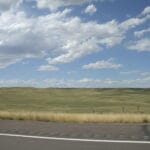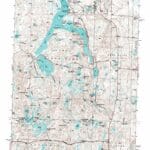Discovering Eureka’s Silver Lining
High up in the East Tintic Mountains, at an elevation of 6,430 feet, sits Eureka, Juab County, Utah. This town, nestled amidst breathtaking mountain scenery, boasts a history as rich as the silver ore that once fueled its bustling economy. Eureka isn’t just another town; it’s a living testament to the boom-and-bust cycles of the American West, where the echoes of a vibrant past resonate with the quiet resilience of the present.
From Ruby Hollow to Silver Boom
Originally known as Ruby Hollow, Eureka’s story took a dramatic turn in 1870 with the discovery of silver. The name “Eureka,” a Greek word meaning “I have found it!”, likely erupted from the lips of excited prospectors, forever marking the town’s destiny. This newfound wealth propelled Eureka to the heart of the Tintic Mining District, spanning both Juab and Utah counties. The town rapidly transformed into the district’s financial center, a bustling hub of commerce fueled by the promise of silver and the grit of hardworking miners. The Tintic Mining District, organized in 1869, was thriving by 1899, and Eureka, incorporated as a city in 1892, became its beating heart.
Beyond Silver: Unexpected Innovations
While silver defined Eureka’s early identity, the town’s legacy extends beyond its mining heritage. Surprisingly, Eureka is the birthplace of Frank Zamboni, the ingenious inventor of the ice resurfacing machine. This unexpected connection adds a unique layer to Eureka’s story, linking the rugged world of mining to the smooth, icy surfaces of skating rinks worldwide.
A Journey Through Time on U.S. Route 6
Today, U.S. Route 6 serves as Eureka’s Main Street, offering a captivating journey through time. The remnants of a bygone era line the road, whispering stories of saloons filled with boisterous miners, general stores overflowing with provisions, and families who carved out lives amidst the boom and bust cycles. This scenic route connects Eureka to Santaquin, 20 miles to the east, and Delta, 51 miles to the southwest. For those seeking outdoor adventure, the towering peaks of Packard, Godiva, and Eureka Ridge, visible to the north and south, beckon with breathtaking views and challenging hikes.
A Resilient Community: Preserving the Past, Embracing the Future
Eureka’s population, while smaller than its peak (669 in 2010, down from 766 in 2000), reflects a resilient community deeply connected to its roots. The Tintic Mining Museum stands as a testament to this connection, offering visitors a fascinating glimpse into Eureka’s mining legacy. The museum serves as a bridge between the past and the present, preserving the stories of the men and women who shaped the town’s identity.
Like many small towns, Eureka faces the challenge of balancing its rich heritage with the need to adapt and evolve. Ongoing discussions within the community focus on sustainable tourism and economic development, seeking to preserve the town’s unique character while embracing the opportunities of the future. This ongoing dialogue suggests that Eureka is not merely a relic of the past, but a living community actively shaping its future.
What is Eureka Utah Famous For?
Eureka, Utah, is more than just a dot on the map; it’s a town brimming with stories. It’s a place where the echoes of a booming mining past intertwine with the quiet charm of a modern mountain town. So, what exactly is Eureka known for?
A Silver Rush Town Carved from the Mountains
The discovery of silver in the 1870s transformed the once-unassuming Ruby Hollow into the bustling boomtown of Eureka. “Eureka!” – likely the joyous exclamation of prospectors upon their discovery – became the town’s name, forever linked to the silver that fueled its rapid growth. Eureka became the heart of the Tintic Mining District, a vibrant hub of activity fueled by dreams of striking it rich. The clang of pickaxes, the rumble of ore carts, and the boisterous laughter of miners once filled the air, and today, walking the streets of Eureka, you can almost feel the phantom vibrations of that era.
A Living Museum of the Wild West
Eureka’s place on the National Register of Historic Places underscores its remarkably preserved 19th-century architecture. These buildings aren’t just structures; they’re time capsules, whispering stories of a bygone era. They offer glimpses into the lives of the miners, merchants, and families who shaped Eureka’s identity, their resilience etched into the very stones of the buildings.
From Mines to Ice Rinks: The Zamboni Connection
Beyond silver, Eureka boasts a surprising claim to fame: the birthplace of Frank Zamboni, the inventor of the ice resurfacing machine. This curious connection links the rugged world of mining to the smooth, icy surfaces of skating rinks worldwide, adding an unexpected dimension to Eureka’s story.
Eureka Today: A Blend of History and Modern Adventure
Nestled amidst the breathtaking scenery of the East Tintic Mountains, Eureka offers a unique blend of historical charm and outdoor recreation. Explore the historic Main Street, lined with preserved buildings, and then venture into the surrounding wilderness for thrilling ATV rides or peaceful hikes. Whether you’re a history buff, an outdoor enthusiast, or simply seeking a unique getaway, Eureka offers an experience that connects you to the past while embracing the present.
Discover the hidden gems and rich history of Ellenboro NC County. Explore the charming southern town and its surrounding areas in Eutaw Alabama, where history and hospitality intertwine.
What Happened to Eureka, Utah?
Eureka, Utah, a name once synonymous with silver riches and bustling activity, now stands as a quieter testament to the boom-and-bust cycles of the American West. So, what shaped Eureka’s destiny, and what is life like there today?
From Boomtown to “Semi-Ghost Town”
The discovery of silver in the 1870s transformed the once-sleepy Ruby Hollow into the thriving boomtown of Eureka. It became the financial center of the Tintic Mining District, attracting people from all walks of life eager to stake their claim in the burgeoning silver empire. Fortunes were made and lost, and the town pulsed with a frenetic energy. However, like many mining towns, Eureka’s prosperity wasn’t destined to last.
After the roaring 1920s, the silver boom began to fade. The easily accessible ore had been extracted, and fluctuating silver prices impacted the profitability of the mines. Gradually, operations scaled back or shut down altogether. The bustling streets grew quieter, and Eureka transitioned into a more reflective phase, sometimes referred to as a “semi-ghost town.”
Eureka’s Enduring Spirit
Despite the decline of mining, Eureka has persevered. Its Main Street still pulses with life, a blend of historic buildings and modern businesses. The town embraces its history while looking towards the future. Ongoing reclamation projects aim to mitigate the environmental damage caused by mining, demonstrating Eureka’s commitment to both its past and a sustainable future.
Eureka Today: Balancing Heritage and the Future
Eureka’s story is one of resilience, adaptation, and the enduring spirit of a community. While the boom days may be over, the town continues to evolve, balancing its rich heritage with the challenges and opportunities of the present day. The surrounding East Tintic Mountains offer breathtaking natural beauty, providing context to Eureka’s story and opportunities for outdoor recreation. U.S. Route 6, which traverses Eureka’s Main Street, connects the town to the wider world, serving as a reminder that while Eureka retains its unique character, it remains connected to a larger, interconnected narrative.
What Did They Mine in Eureka, Utah?
Eureka, nestled in the East Tintic Mountains, wasn’t always the quiet town it is today. It once buzzed with the activity of miners seeking their fortunes beneath the earth. So, what treasures did they extract from the mountains?
More Than Just Silver: A Diverse Mineral Wealth
While gold and silver were the primary draws, attracting prospectors from far and wide, Eureka’s mines yielded a surprising variety of resources. Alongside the precious metals, miners extracted substantial amounts of copper, lead, and zinc, essential materials for the burgeoning Industrial Age.
The “Big Four” Mines: Driving Eureka’s Economy
The mining operations in Eureka centered around four major players, the “Big Four” mines: Bullion Beck and Champion, Centennial Eureka, Eureka Hill, and Gemini. These mines were the engines driving Eureka’s economy, each with its own story of ambition, risk, and contribution to the town’s boom. The Chief Consolidated Mining Company later became another major player in the district.
Triumphs and Tragedies: The Life of a Mining Town
Life in Eureka’s mining heyday was a rollercoaster. Fortunes were made and lost, and the community experienced both triumphs and tragedies. The 1914 Centennial-Eureka Mine disaster, a devastating cave-in that claimed the lives of eleven miners, serves as a somber reminder of the risks inherent in the industry. A severe snowstorm in 1917 further tested the community’s resilience, halting all railroad activity in the area.
Eureka’s Mining Legacy: A Story of Resilience
Eureka’s mining legacy is more than just a tale of extracted minerals; it’s a story of human endeavor, resilience, and the enduring spirit of a community that faced both prosperity and adversity. Today, walking through Eureka, you can sense the echoes of the past, the hopes, dreams, and struggles of those who carved this town out of the mountainside. While the peak of mining has passed, Eureka’s story continues, a testament to its ability to adapt and evolve. It’s a place that invites exploration, reflection, and connection with a unique chapter in American history.
- Unlock Black Pepper’s Secrets: A Complete Guide - April 26, 2025
- Discover Long Black Pepper: Flavor & Health Benefits - April 25, 2025
- Shocking Twists: The Grownup Review: Unreliable Narration - April 25, 2025
















